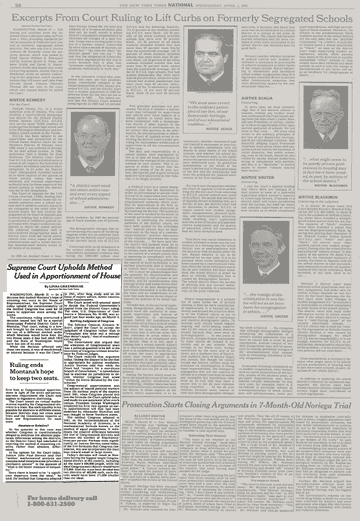The Supreme Court unanimously overturns the District Court ruling
Though the decision of the district court ruled in favor of Montana, the following year came with an appeal to the decision. The Supreme Court unanimously ruled to overturn the 1991 decision of the District Court. Justice Stevens details three main arguments in the defense of overturning the decision of the District Court [92b].
The first argument discusses the credibility of the Hill method as means for resolving the fractional remainder problem. The problem, called the fractional remainder problem, arose as a result of the Constitution stating that the number of representatives shall never exceed one for every 30,000 person [92b]. In other words, the Constitution does not specify how to allocate with regard to a State’s population. For example, suppose the U.S. is composed of three states where State A has 100,000 residents, State B has 300,000 residents, and State C has 400,000 residents, and the U.S. House of Representatives has seven seats. This situation would produce the fractional remainder problem as 800,000/7 produces a fractional number and, thus, does not evenly divide the populations of any State. As a result, the Federal Government must determine an apportionment method that determines how to deal with the fractional remainder problem within the guidelines of the Constitution. Justice Stevens affirmed that the Hill method for was an appropriate selection by Congress and that it was just as appropriate as the Dean method, even if it resulted in a larger range of district sizes .
The second argument seeks to clarify the rationale for overturning the lower court’s decision. In particular, it seeks to protect the right of the Judicial system to rule on the matter of representative apportionment, declaring that it is not a “political question” which is protected by prior precedent [Oye18b]. The argument confines the overturning to being a result of the district court’s error in Constitutional interpretation, not their standing to rule on the issue.
The final argument made was that although the Dean method would have resulted in a “decrease [in] the absolute deviation from the ideal district size, it also would increase the relative difference between the ideal and the size of the districts in both Montana and Washington” [92b]. As such the consequence of changing methods is not clear cut and lays outside the Wesberry standard there isn’t a guide to which difference matters more. This leads to the conclusion that Congress has the power to adopt the Hill method, and would be justified in doing so thanks to the long-standing support from both prior experience and scholarly opinion.


